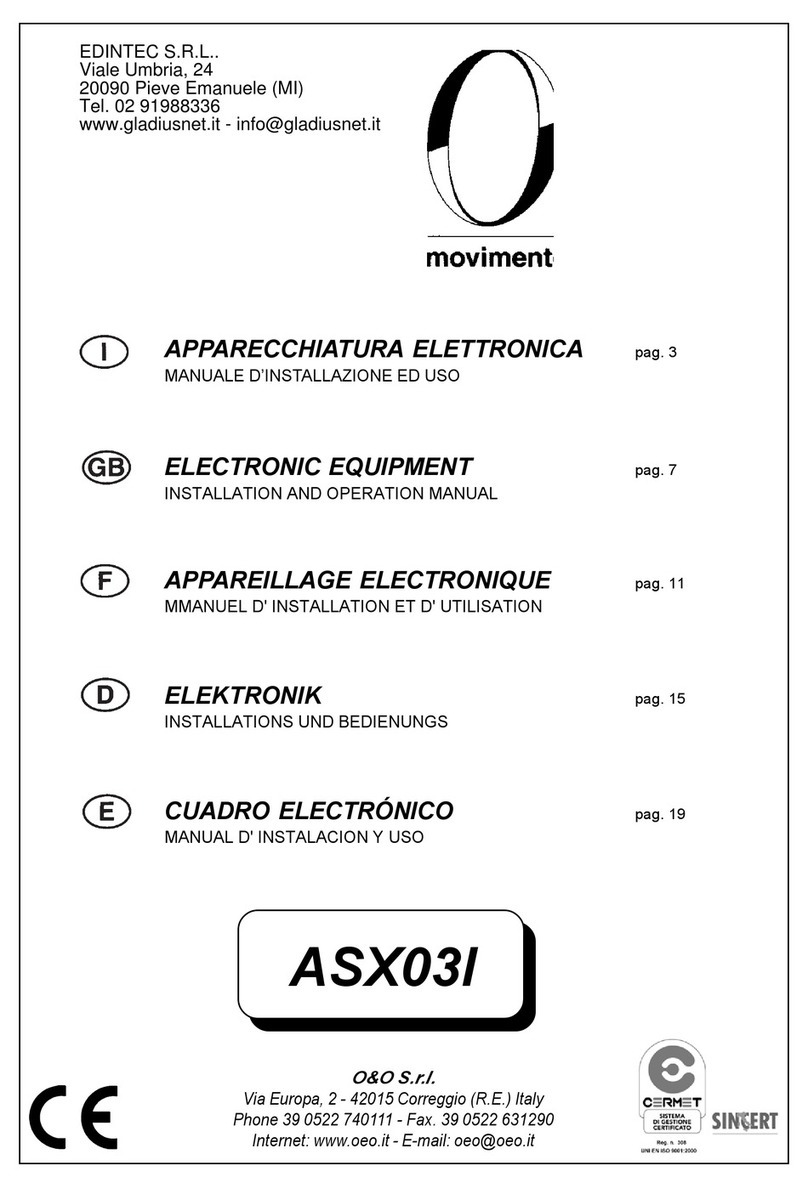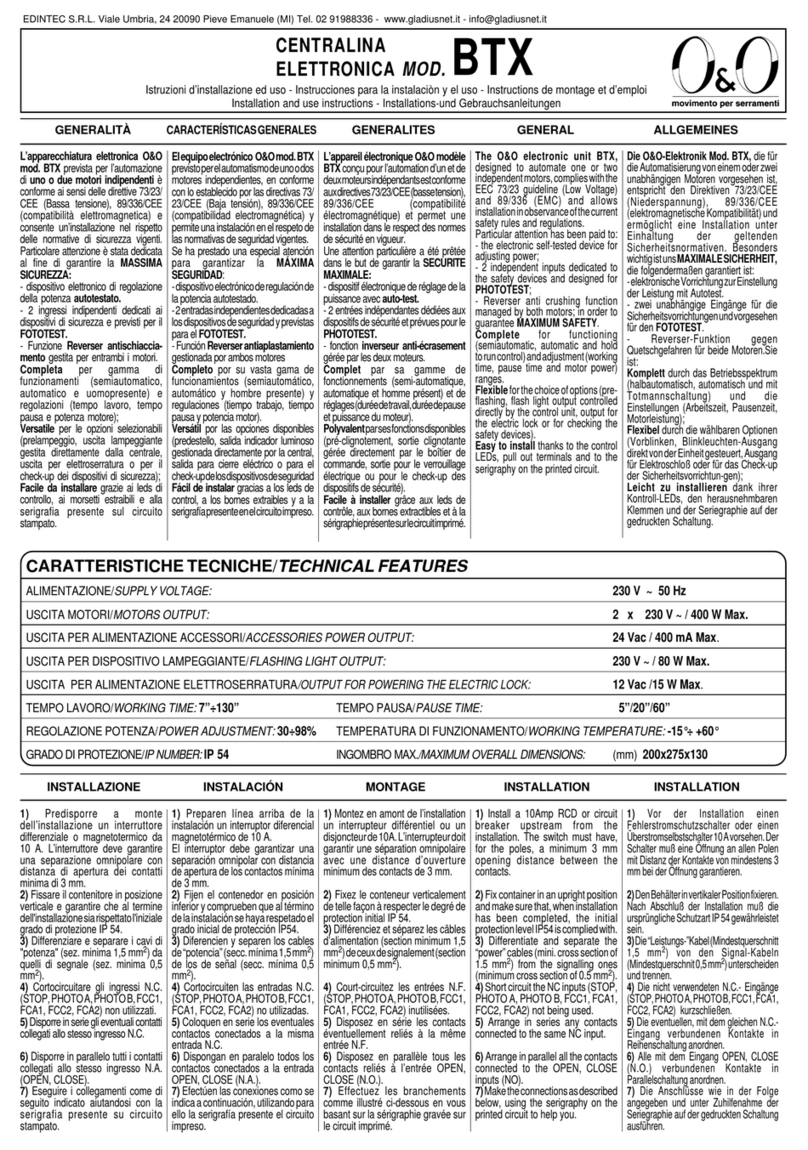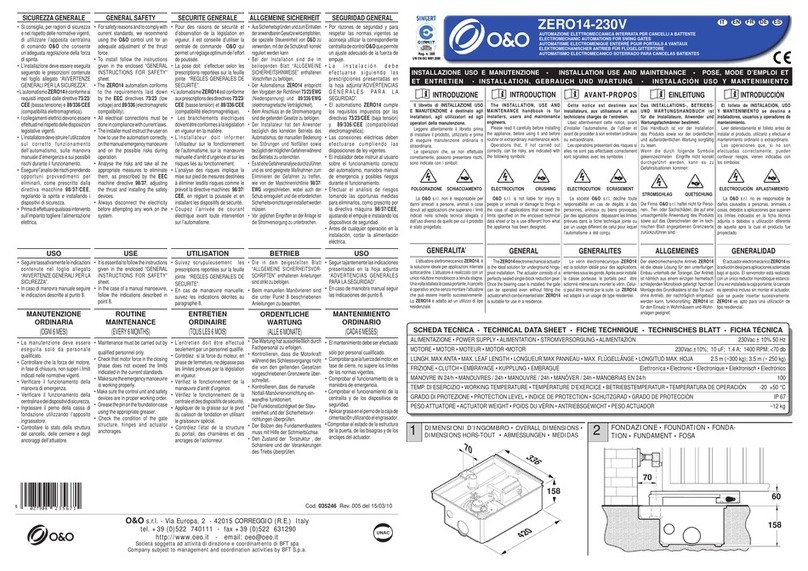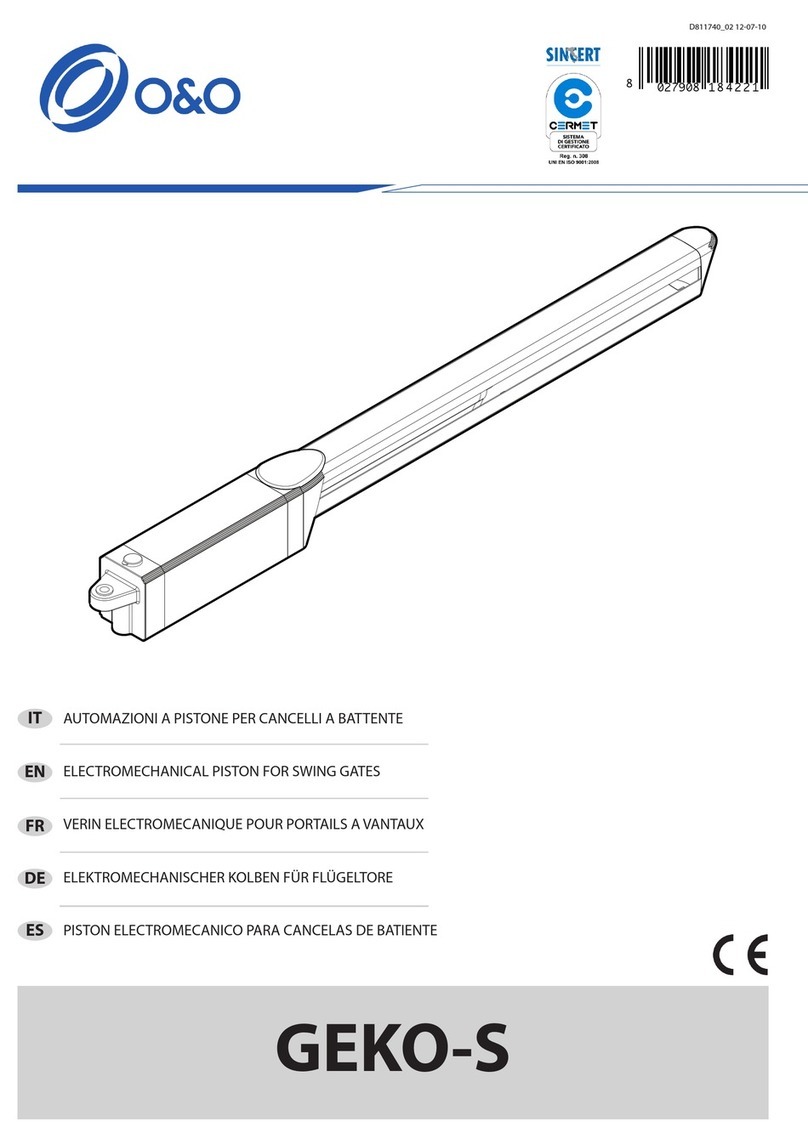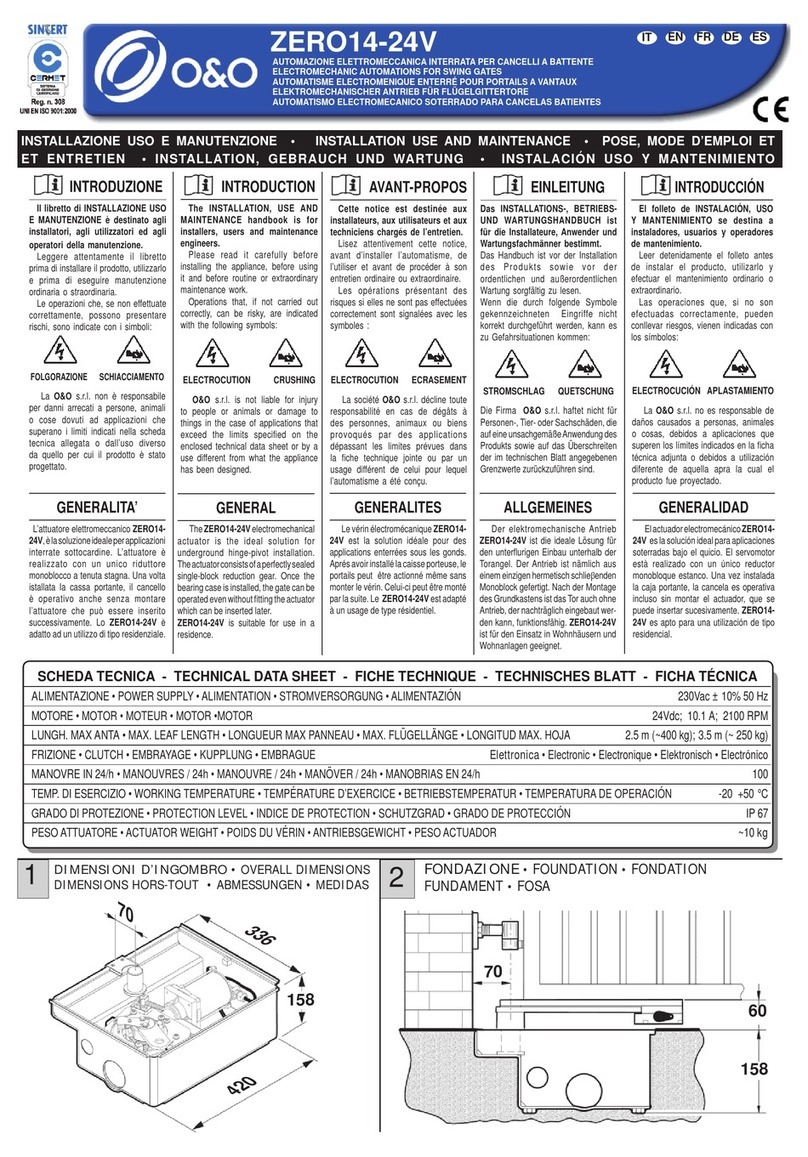
AVERTISSEMENTS GÉNÉRAUX FRANÇAIS
ATTENTION!Consignesdesécuritéimportantes.Lireetsuivreattentivement
la brochure Avertissement et le livret d’instructions fournis avec le produit
sachant qu’une installation incorrecte peut provoquer des dommages aux
personnes, aux animaux ou aux choses. Elles fournissent des indications
importantes concernant la sécurité, l’installation, l’utilisation et l’entretien.
1) SECURITE GENERALE
ATTENTION! Une installation erronée ou une utilisation impropre du
produit peuvent provoquer des lésions aux personnes et aux animaux
ou des dommages aux choses.
• Eliminer les matériaux d’emballage (plastique, carton, polystyrène etc.)
selon les prescriptions des normes en vigueur. Ne pas laisser des enve-
loppes en nylon et polystyrène à la portée des enfants.
• Conserver les instructions et les annexer à la che technique pour les
consulter à tout moment.
• Ce produit a été conçu et réalisé exclusivement pour l’utilisation indiquée
dans cette documentation. Des utilisations non indiquées dans cette
documentation pourraient provoquer des dommages au produit et
repré-senter une source de danger pour l’utilisateur.
• La Société décline toute responsabilité dérivée d’une utilisation impropre
ou diérente de celle à laquelle le produit a été destiné et qui est indiquée
dans cette documentation.
• Ne pas installer le produit dans une atmosphère explosive.
• Les éléments qui composent l’appareil doivent être conformes aux
Directives Européennes suivantes : 2004/108/CE, 2006/95/CE, 2006/42/
CE, 99/05/CE (et leurs modications successives). Dans tous les pays
n’appartenant pas à la CEE nous vous conseillons de respecter aussi les
normes ci-dessus, outre les règlements nationaux en vigueur, an de
garantir un bon niveau de sécurité.
• La Société décline toute responsabilité en cas de non respect des règles
de bonne technique dans la construction des fermetures (portes, por-
tails etc.), ainsi qu’en cas de déformations pouvant se produire pendant
l’utilisation.
• L’installation doit être conforme aux prescriptions des Directives Euro-
péennes: 2004/108/CEE, 2006/95/CEE, 2006/42 CEE, 99/05/CEE et mo-
dications successives.
• Couper l’alimentation électrique avant d’eectuer n’importe quelle
intervention sur l’installation. Débrancher aussi les éventuelles batteries
de secours.
• Prévoir sur la ligne d’alimentation de la motorisation un interrupteur
ou un magnétothermique omnipolaire avec distance d’ouverture des
contacts égale ou supérieure à 3,5 mm.
• Vérier qu’en amont de la ligne d’alimentation il y a un interrupteur
diérentiel avec seuil de 0,03A.
• Appliquer tous les dispositifs de sécurité (cellules photoélectriques, barres
palpeuses etc.) nécessaires à protéger la zone des dangers d’écrasement,
d’entraînement, de cisaillement, selon et conformément aux directives
et aux normes techniques applicables.
• Appliquer au moins un dispositif de signalisation lumineuse (feu cligno-
tant) en position visible, xer à la structure un panneau de Attention.
• La Société décline toute responsabilité en matière de sécurité et de bon
fonctionnement de la motorisation si des composants d’autres produc-
teurs sont utilisés.
• Utiliser exclusivement des pièces originales pour n’importe quel entretien
ou réparation.
• Ne pas eectuer des modications aux composants de la motorisation
si non expressément autorisées par la Société.
• Informer l’utilisateur de l’installation sur les systèmes de commande
appliqués et sur l’exécution de l’ouverture manuelle en cas d’urgence.
• Tout ce qui n’est pas expressément prévu dans ces instructions, est
interdit.
• L’installation doit être faite en utilisant des dispositifs de sécurité et des
commandes conformes à la norme EN 12978.
CONTROLE DE L’INSTALLATION
Vérier scrupuleusement ce qui suit avant de rendre l’automatisation dé-
nitivement opérationnelle :
• Vérier si tous les composants sont solidement xés.
• Contrôler le fonctionnement correct de tous les dispositifs de sécurité
(photocellules, linteaux pneumatiques, etc.)
• Vérier la commande de la manœuvre d’urgence.
• Vérier l’opération d’ouverture et de fermeture avec les dispositifs de
commande appliqués.
• Vérier la logique électronique de fonctionnement normal (ou person-
nalisé) dans la centrale de commande.
RÉGLAGES DE LA FORCE DE POUSSÉE
ATTENTION : Vérier si la valeur de la force d’impact mesurée
dans les points prévus par la norme EN12445 est inférieure à celle
indiquée dans la norme EN 12453.
La force de poussée se règle de façon très précise avec le dispositif de réglage
électronique de la centrale de commande. Le fonctionnement en n de course
est réglé électroniquement dans le tableau de commande.
Pour garantir une bonne sécurité anti-écrasement, la force de poussée doit
être légèrement supérieure à celle nécessaire pour déplacer le vantail, à la
fermeture et à l’ouverture; la force mesurée à l’extrémité du vantail ne doit
jamais dépasser les limites prévues par les normes citées plus haut.
COMMANDE
La commande peut être de diérents types (manuelle, avec radiocomman-
de, contrôles des accès avec un badge magnétique, etc.) en fonction des
nécessités et des caractéristiques d’installation. Pour les diérents systèmes
de commande, voir les instructions correspondantes.
Lesutilisateursde l’automatisationdoiventconnaîtretouteslesinformations
sur la commande et son utilisation.
INCONVÉNIENTS ET REMÈDES
Mauvais fonctionnement du motoréducteur
• Vérier avec l’instrument prévu à cet eet la présence de tension aux
extrémités du motoréducteur après la commande d’ouverture ou de
fermeture.
Si le moteur vibre mais ne tourne pas, il se peut que:
• Le branchement des ls soit erroné (revoir le schéma de branchement).
• Si le mouvement du vantail est opposé à celui prévu, invertir les bran-
chements de marche du moteur dans la centrale.
La première commande après une coupure de courant doit être ouverture
ARRÊT VANTAIL.
DEMOLITION
L’élimination des matériaux doit être faite en respectant les normes en
vigueur. En cas de démolition de l’automatisme, il n’existe aucun danger
ou risque particulier dérivant de l’automatisme. En cas de récupération de
matériaux, il est opportun de les séparer selon le genre (parties électriques
- cuivre - aluminium - plastique - etc.).
DEMANTELEMENT
ATTENTION: avant d’ouvrir la porte, le ressort doit être déchargé (lisse
verticale). Si l’automatisme est démonté pour être ensuite remonté ailleurs,
il faudra:
- Couperl’alimentationetdébranchertoutel’installationélectrique.Enlever
le vérin de la base de xation.
- Démonter tous les composants de l’installation.
- Si des composants ne peuvent pas être démontés ou sont endommagés,
Lebonfonctionnementdel’actionneurn’estassuréquesilesdonnées
fournies dans ce manuel sont respectées. Le constructeur ne répond
pas pour les dommages provoqués par le non respect des normes
d’installation et des indications fournies dans ce manuel.
Les descriptions et les gures de ce manuel n’engagent pas le
constructeur. En laissant inaltérées les caractéristiques essentielles
du produit, la Société se réserve le droit d’apporter à n’importe quel
moment les modications qu’elle juge opportunes pour améliorer le
produit du point de vue technique, commercial et de construction,
sans s’engager à mettre à jour cette publication.






